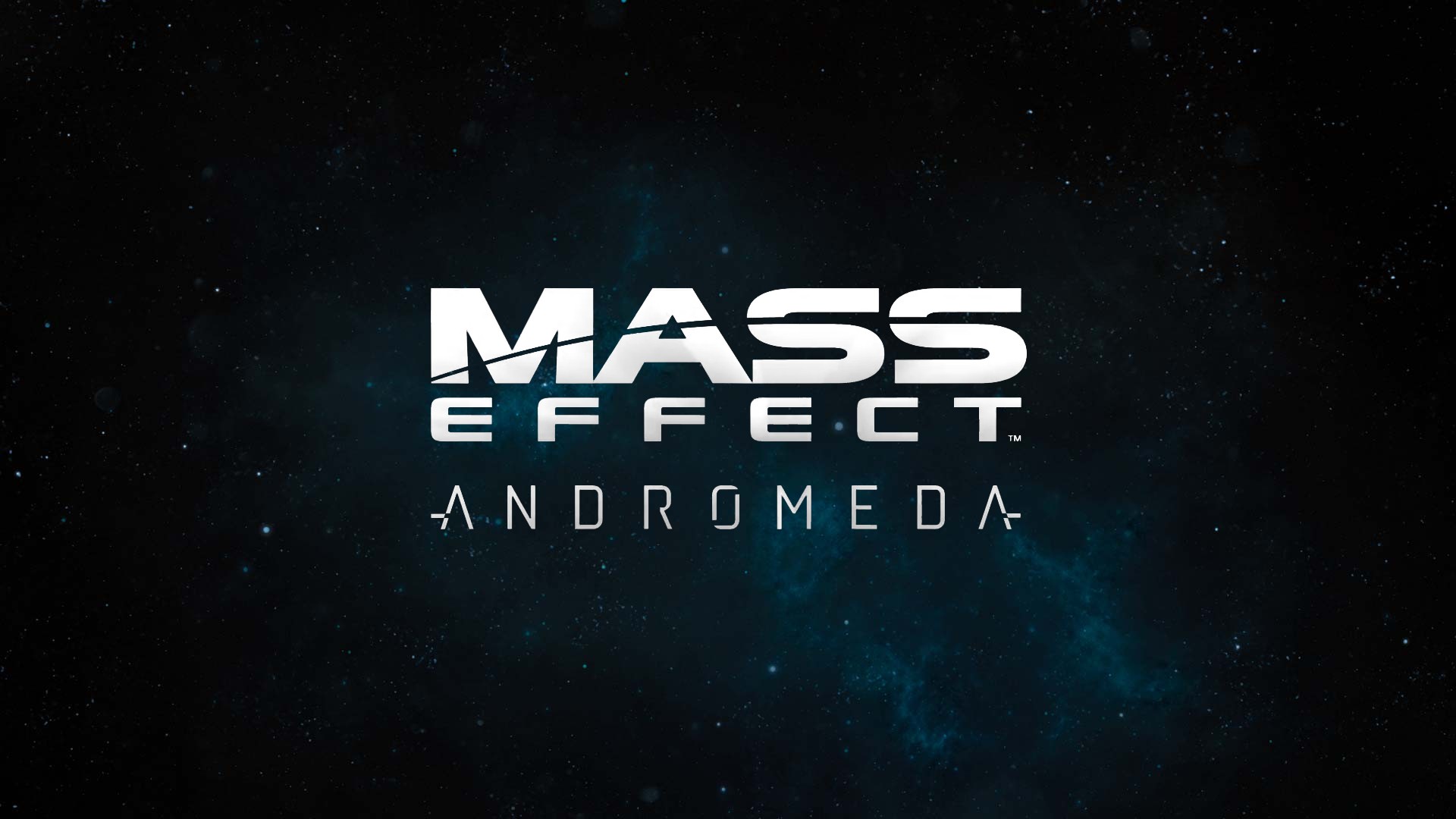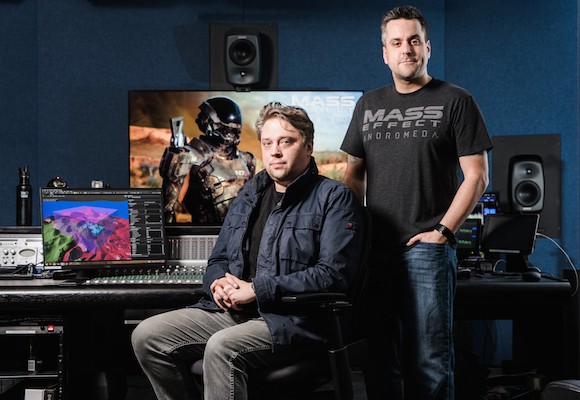
Article by Doug Waters
Edited by Katie Tarrant
Reviewed on: PlayStation 4
Developer: Bioware
Publisher: Electronic Arts
Composer: John Paesano
Audio Directors: Michael Kent, Jeremie Voillot
As I’m sitting here, prepared to type, I’m struggling to come up with an introduction that will do the Mass Effect trilogy justice. Never has a game series affected me so profoundly, both in enjoyment of gameplay and emotive storytelling. For the last five years, since Mass Effect 3 was released, whenever anyone has asked me what my favourite game was, I never hesitated in my response of “Mass Effect”. This was a game series into which I invested hundreds of hours of my free time and enough money to purchase all the DLC to supplement my experience!
Rumours had been circulating for a while before this, but you can imagine my excitement when, at E3 2015 the first details of Mass Effect: Andromeda were revealed! Jump forward nearly a year and a half, after a short delay from its initial planned 2016 release date, and the latest instalment of the series is here!

The story is set in a completely new galaxy, separate from the events that take place during the original trilogy. When humanity is threatened by the ‘Reaper’ invasion, a group of ‘arks’ leave the Milky Way Galaxy in search of a new home for humanity. After 600 years in cryo-sleep, your character awakes, the ‘Pathfinder’ for humanity, tasked with finding a new system for the human race to settle in.
SOUND
One of the main things that drew me to the original trilogy was the incredible sound design throughout. Whilst studying at university, I recall visiting the flat of one of my friends on the course and playing Mass Effect for the first time. We were so amazed by the synthetic elements that made up the ‘biotic’ sounds that they became a constant topic of discussion for the next year or so; largely contributing to our interest in purchasing and messing around with hardware synths. Naturally when I got my hands on Andromeda, I was eager to first of all hear the sounds of the main characters biotic powers.
It was nice to hear the same ‘liquidy’ textural synthesis that was used in the original trilogy, once again utilised to craft the biotic powers and the sounds of the characters jet pack; a new means of traversing the environment, unseen in the previous titles. These are by far some of the most fun sounds in the game, especially when chained together.
Mass Effect has always been a very cinematic experience; epic cut-scenes telling the story of key moments in the saga with epic sound design to match. Mass Effect: Andromeda is no different; the sound design in the opening cinematics of the game is nothing short of incredible. There’s such a wealth of sonic textures that never seem to interfere with one another, from an Ark dropping out of hyper space, to the servos of the robotic systems waking up the Ark’s passengers from cryo-sleep. It also appears that either granular or wavetable synthesis was used to awesome effect to give certain moments in these cinematics a unique sonic character.
There are also some great environmental ambiences, especially on the first planet you visit as part of the main storyline. The distant groaning sounds, lightning strikes and the use of reverb really sells the size of the whole area, as well as giving it a unique textural background. However, it was a shame that in some cinematics, occasional ambiences and background sounds seemed to be missing. Although, this could have just been a bug with the in-game procedural foley system.
In the March 2017 edition of Develop magazine, Michael Kent and fellow BioWare audio director Jeremie Voillot describe how their system uses “physics-generated events and parameters to play loops and ones shots, emulating movement and footfalls”. They argue that this played an essential part in creating the sound design for the game’s 500+ cinematics, as it allowed them to no longer be dependent on the animation team, removing the need for constant iterations when animations got changed.
In this interview they also detailed their Procedural Locator Object Placement System (or ProLo for short). This allowed for the flagging of particular objects and the system then associated a sound with it, for instance, ‘fire’ ‘flag’ or ‘tree’. Level designers were then able to move stuff around, requiring very little subsequent work from the audio team.
The ProLo system also allowed for a great level of detail with how objects reacted to wind. Kent and Voillot talk about how they were able to take the ‘WindSpeed’ at a location and use that to modulate the playback of sounds for all objects in that area. They describe it as being like “a very detailed bubble” of sound around the player, with trees, fire and such all reacting together, constantly updating as a player moves around the world.
Where the sound design really shines however is in combat. The layers of detailed textures make for an incredibly immersive third person sci-fi shooter experience. Playing Mass Effect: Andromeda and hearing the sounds of the biotic powers and weapons brought back so many beloved memories of playing the original trilogy. Personally I often found the footstep sounds whilst walking around inside the space-ships a little ‘flappy’, like the character was wearing huge clown shoes, but this didn’t massively detract from the experience. Overall the audio team at Bioware have done an incredible job and really taken the sonic experience of the Mass Effect universe and turned it up a notch.
MUSIC
Whilst featuring some of the most amazing sound design I’ve heard in a game series, I was equally as drawn to the original Mass Effect trilogy for its epic orchestral/synthetic hybrid music. It was a wealth of music that completely captured the futuristic aesthetic of the setting, yet portrayed the huge scale of the epic storyline across all 3 games.
Composer John Paesano (Maze Runner films, Daredevil TV series) has perfectly captured the ‘flavour’ of the franchise; complimenting the pre-existing library of Mass Effect music whilst delivering it in his own style. Solo horns punctuate the score giving it a feeling akin to the opening music of Bungie’s Destiny, whilst the main theme feels very reminiscent of some of the music from Mass Effect 2. The reveal of Mass Effect: Andromeda’s ship, the Tempest, felt like it rather heavily referenced the reveal of the Normandy SR-2 in ME2.
The audio team at Bioware developed a highly flexible music system that Kent and Voillot describe as “a hybrid of traditional music scripting with a completely parametric and contextual procedural system”, able to detect you’re in combat, calculate how ‘stressful’ the engagement is, and can you buy clonazepam online transition to the appropriate intensity level of music. On top of and in sync with this combat, music stingers can also be heard after a player might, for example, score a headshot kill. This continues to owe to the highly cinematic and engaging combat experience. However, at times when the music is very sparse, these stingers can stand out too much and become slightly distracting.
Similar to other shooter games such as the Call of Duty series and EA DICE’s Battlefield series, when at low health and near death, a filter is applied to all the audio, music and sound effects alike. This works perfectly to draw the player’s attention to the current status of their health, informing them that they need to find cover before rejoining the fight.
Cleverly, when out of combat and engaged in conversation with other characters, the system can also read the mood line-by-line and adjust the music accordingly. Kent and Voillot describe how this was a great opportunity for collaboration with the writing team, since they knew best the context that needed to be supported.
Diversely, I occasionally found that encounters with small groups of enemies often triggered music that seemed too dramatic for the size of the engagement. It was particularly distracting when driving close to these enemies, as epic encounter music played when I had no intention of leaving the Mako to engage them.
Similarly the first time you meet Drack, the Pathfinder’s ‘Krogan’ team member, the music makes his entrance seem a little too dramatic, but this is the only instance I’ve come across so far in which this has been the case and I still have much of the game to play!
Overall I’ve been very impressed with John Paesano’s work on bringing this game to life through music. It’s a soundtrack that sits perfectly alongside the rest of the Mass Effect music in my collection (favourite tracks of mine include ‘A Trail of Hope’ and ‘Heleus’). Not bad at all for a composer not just new to the Mass Effect franchise, but for whom Mass Effect: Andromeda is their debut work as a composer for video games! I’ll be very interested to see how he develops the musical groundwork he’s laid down if BioWare work with him on subsequent Mass Effect titles.
Voice Acting
As with the previous Mass Effect games, it’s possible to choose to play as either male or female. The only difference is that the one you don’t choose becomes your twin sibling in the story. Fryda Wolff and Tom Taylorson do a great job of bringing Sara and Scott Ryder to life, giving performances heavy with emotion and sincerity. It’s a great shame, therefore, that the quality of the reportedly outsourced and much maligned facial animations don’t quite match up to the emotions portrayed by the voice-actors. There are also moments when certain lines aren’t spaced apart enough to seem like they’re being said naturally. This appears to occur when switching to a different camera angle during some cut-scenes.
Interesting processing on some of the vocals contributes to what I mentioned earlier about missing ambiences. In these moments you can hear so much of the reverb and room size in the tails of the lines of the character in focus, but very little of the voices or vocal reflections of other characters and NPC’s in that same room. This mismatch between the visual busyness in the scene and the lack of matching busyness in the audio was at times a little distracting.
Yet, one thing I’ve always found the Mass Effect trilogy to do effectively is the processing of the voices for alien races, and Mass Effect: Andromeda is no different. Standout examples include new races, the ‘Kett’ and the ‘Angara’, whose processing gives them a unique flare and sound next to franchise favourites such as the ‘Turians’ or ‘Krogans’.
Overall
Whilst Andromeda may have arguably taken a beating based on the poor facial animation, if you can fight through it, you’ll uncover a game filled with great storylines and characters, made better only through one of the most textural sound design palettes I’ve heard in a game in a long while, and accompanied by some of the most uplifting and emotive music, and incredible voice acting.
LINKS
Official
We hope you enjoyed Doug’s review, check out others in our Reviews section. Don’t forget to sign up to our Monthly Newsletter to make sure you don’t miss out on our reviews and interviews.
We’re also running a Patreon campaign to make sure we can keep bringing you regular, high quality content if you’re feeling generous! Thanks for even sharing!
The Sound Architect





